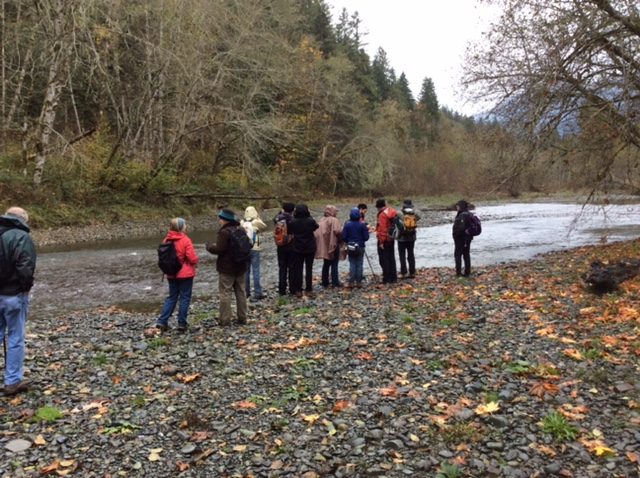 On October 6, 2016, the JLT Natural History Society sponsored a presentation on the remarkable history and stewardship efforts of the Hoh River Trust. Executive Director Mike Hagen explained how the trust was formed to obtain and manage lands along the Hoh between the Olympic National Park and the Pacific Ocean.
On October 6, 2016, the JLT Natural History Society sponsored a presentation on the remarkable history and stewardship efforts of the Hoh River Trust. Executive Director Mike Hagen explained how the trust was formed to obtain and manage lands along the Hoh between the Olympic National Park and the Pacific Ocean.
Of the roughly 250,000 rivers across the continental US, the Hoh is arguably one of the most unspoiled. It flows virtually intact for 56 miles from its source high in the Olympic Mountain range down to the Olympic National Marine Sanctuary. The river corridor contains what many consider the world’s richest old-growth and temperate rainforests. These ecosystems provide critical habitat for endangered and threatened species including marbled murrelet, spotted owl, and bull trout, along with diverse other wildlife, such as elk, black bear, and cougar. The river itself supports some of the healthiest native salmon and steelhead runs in the “Lower 48.”
 Within the lower reaches of the river, 30 miles beyond the Olympic National Park boundary, some 10,000 acres encompassing a mile on either side of the river are designated “at risk.” Over the last century, much of this area was managed for commercial timber harvest, and it is now in various stages of regeneration. Restoring the vitality and resilience of these lands for the benefit of fish, wildlife, and humans is the mission of the trust. In its short, twelve-year history, the trust has already acquired nearly 7,000 acres.
Within the lower reaches of the river, 30 miles beyond the Olympic National Park boundary, some 10,000 acres encompassing a mile on either side of the river are designated “at risk.” Over the last century, much of this area was managed for commercial timber harvest, and it is now in various stages of regeneration. Restoring the vitality and resilience of these lands for the benefit of fish, wildlife, and humans is the mission of the trust. In its short, twelve-year history, the trust has already acquired nearly 7,000 acres.

 On October 13, 2016, the Natural History Society joined for an autumn hike on the Jefferson Land Trust property along the Duckabush River. It was an easy hike over uneven terrain.
On October 13, 2016, the Natural History Society joined for an autumn hike on the Jefferson Land Trust property along the Duckabush River. It was an easy hike over uneven terrain. We suggested: hiking shoes, dressing in layers, a field guide to plants or birds, binoculars, food, and water. There was no limit to the size of this group.
We suggested: hiking shoes, dressing in layers, a field guide to plants or birds, binoculars, food, and water. There was no limit to the size of this group. Janell at jltnatural@saveland.org was the contact for carpool information and other details.
Janell at jltnatural@saveland.org was the contact for carpool information and other details.




 At different times of the year, trilliums and rhododendrons bloom, ducks float on the tranquil lake, and songbirds nest along the shoreline.
At different times of the year, trilliums and rhododendrons bloom, ducks float on the tranquil lake, and songbirds nest along the shoreline.